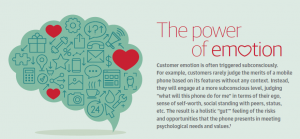It’s not emotion that matters, but what it means

No customer walks out of a store saying “that was a great 8.5 out of 10 experience.” And no customer obsessively measures each physical touchpoint of an experience to come up with an objective algorithm for personal well-being.
Instead, customers pay attention to and remember what is salient to them and ignore the rest. They use emotion to guide their decision-making.
And this is entirely understandable. Often it is impossible to calculate objectively what to do next. For instance, decisions such as, “which restaurant to go to,” “should I trust that rep,” or even “which pen should I use?’’ require an understanding of subjective preferences. Hence, while cognition identifies what we pay attention to, it’s our emotional response that tips the balance of options one way or another.
To quote neuroscientist Antonio Damasio, emotions are “not a luxury, but essential to rational thinking and normal social behavior.”
But there is a catch. If we accept emotion is important to decision-making, we must also accept that emotions do not act alone.

Figure 1 shows that, when CX professionals design for emotion, they must first consider how consumers think about their well-being. Only then are their emotions alerted. This also shows how any emotional reaction acts as feedback to cognition; letting us know what we should remember for next time.
In other words, emotions and cognition come together around well-being (or how we appraise situations), they are not separate entities.
Professor Daniel Kahneman describes well-being in terms of the content of feelings and their intensity. For consumers this is substantially driven by goal attainment, standards of behavior, and evaluation of objects (Ortony, Clore and Collins) as they relate to what is meaningful “to me.”
In essence then ‘it’s not emotion that matters, but what it means.’ Start with a close understanding of consumer well-being, then we can start to emotionally engage.
Hence, those CX approaches that claim there is an ROI of emotion; we should just add joy, delight or any other prototypical emotion state ‘dangerously’ miss the point.
To assume otherwise leads us down the path of putting in place ‘experiences’ that are non-durable, cost us money and in fact have no meaning to the consumer precisely because we did not consider consumer needs and wants when we put them in place. So ‘that themed restaurant’ from the firms point of view may seem like it evokes delight, when in fact the consumer couldn’t care less or even holds a negative reaction. Likewise, an IT vendors focus on avoiding the risk of a negative emotion (loss aversion), may imply selling more hygiene if there has been no customer beta test.
Emotion reframes CX strategy
Nonetheless, even though we have to get behind emotion to understand it, consideration of emotion still challenges our perspective on how to deliver customer experience. For instance, seen through its lens:
• Customer experience becomes less about physical touchpoints and more about how they are weighted and defined by their impact on the customer personally: so, rather than care about the fact that your company has a workable website, by asking the question how does this feel to the customer? We see beyond the physical website and realize that we might want to care about say ‘look and feel.’ After all, no customer thinks about the website being ‘of value’ they think about the outcomes from using that website which in turn affect how they feel.
• Linear journey maps becomes less important, since issues that affect me personally can come from anywhere, including outside the journey under consideration: which means that companies need to understand customer encounters2 rather than how CX is delivered against fixed touchpoints. For instance, with one operator, we looked at network satisfaction. Using customer (as opposed to NLP) rated narratives we uncovered that customer service and billing were key influences on how customers felt towards network perception; even though these had no direct relationship to mobile signal.
• Consideration of what a score means personally informs our understanding of quantitative measures of customer satisfaction and sentiment; uncovering hidden bias1: after all, a 9 or 10 can be just a tick in the box without emotional resilience or commitment3 since I gift you a score based on high market share. A finding from one Indian operator was that customers tended to score 9s and 10s but not mean it: in fact one-third of respondents who actively ticked 9 and 10 also said they would never, ever recommend the operator. If we had not looked behind the response to uncover how customers felt we would have assumed we were doing well.
• Emotion being frequently fleeting and non-consciously received, expands our horizons on how to look at customer well-being: as we can see in the diagram below – the power of emotion – a lot of how we feel relates to ‘in the moment’ and sub-consciously judged effects.

(Text: customer emotion is often triggered subconsciously. For example, customers rarely judge the merits of a mobile phone based on its features without any context. Instead, they will engage at a more subconscious level, judging “what will this phone do for me” in terms of their ego, sense of worth, social standing with peers, status, etc. The result is a holistic “gut” feeling of the risks and opportunities that the phone presents in meetings psychological needs and values (source: Dr Simon Moore, Innovation Bubble).
• Understanding customer emotions should not just be confined to preventing loss aversion: making things work may not impact our well-being if it is a given. To create emotional engagement companies may be better off looking at designing in more meaningful encounters.
An emotional framework for CX
So if emotions are important, how do we map them? Well firstly, don’t throw away any process mapping frameworks. But hold back on them until you have engaged an open process of listening and learning what the emotional customer experience is or could be.
Step 1: Become culturally attuned to emotional awareness
Engage mindset change so employees and leadership become more aware of the emotional elements of the customer experience. Ensure governance and cross-silo processes are in place that support a culture of emotional empathy.
EXAMPLE: A Swiss insurer used mobile apps to deliver weekly CX tasks to its champion network and social communities to distribute social listing into the C-suite and across departments. Other companies use social data or immersion ‘in the experience’ or ‘exemplar experiences to open the eyes of the C-suite.
Step 2: Identify emotional situations through measurement
Unfortunately, traditional voice of the customer (VOC) and voice of the employee (VOE) solutions are not set up for emotional measurement. For instance, scaled surveys are blunt instruments that assume customers are cost-benefit calculators and text analytics may over- or under-interpret emotion.
To get closer to customers, use multi-method approaches: behavioral analytics (what people do); social listening (what people say), behavioral psychology (what people don’t say) and the emerging science of story metrics. Stories are the fundamental currency of emotional response; we tell people when things go wrong, we remember anecdotes that are emotionally impactful. One vendor uses the interesting metric “more stories like this, fewer stories like that.” 3
EXAMPLE: Starbucks understands that customers don’t just buy coffee, they buy the emotional demands coffee satisfies—a place to sit down and talk to friends. Functional questions such as ‘did you like that coffee’ would never get to that hidden motivation. Other companies use digital breadcrumb data and heat maps to observe situations of ‘confusion’ (confirmed through correct placement of surveys).
Step 3: Identify potential emotional opportunities
Use data from the business (through analytics and collecting ideas from staff and customers) and from benchmark experiences (such as Amazon or Mandarin Oriental) to identify opportunities to change the emotional feel of the journey. Mapping out customer ‘goal’ hierarchies will also help: reference cognitive psychology approaches such as those outlined by Ortony.
EXAMPLE: Delta Airlines used social media to collect stories. In so doing it found peaks of negative emotion about flight turnaround times among New York executives. This had a direct impact on operating expense investment and customer loyalty. Furthermore, by identifying the ‘well-being’ event, it could scan the environment for similar flashpoints. In addition to storymetrics (based on complexity theory) and our own CX vector, a recent addition to the metric environment that brings us closer to understand ‘emotional opportunity’ is the use of goodwill; where surveys focus just as much on building relationship (Next Best Question) as insight.
Step 4: Collaborate across silos to prioritize innovation designs
There will be many times when a change activity requires cross-silo stakeholder support. It’s critical to get all stakeholders to agree on the program cadence and KPIs.
EXAMPLE: Financial institution RBS and telecom Du both run virtual teams with the purpose of redesigning journeys and resolving key moments of pain with input from multiple perspectives in different locations. Since issues can arise from anywhere, it’s necessary to engage all stakeholders from technology, marketing, services and operations when developing a solution. Interestingly, Steve Whitty (RBS) also added in the cost side of CX in service design; hence getting critical buy in from finance.
Step 5: Design the journey using trial and test
Enable the innovation space to design and test the emotional encounter by using fast prototyping and design thinking.
EXAMPLE: One loyalty points company set up a ‘trial and test’ environment to see the impact of creative changes. This used nontraditional KPIs attached to the activity, such as Facebook likes rather than NPS. Sometimes, we can only know the result by ‘doing’ not by pre-prediction: an important principle in CX.
Step 6: Communicate emotionally with everyone
Ensure that any changes are communicated emotionally not just to customers, but also to the employees who deliver them.
EXAMPLE: American Express spread the message of success through shared employee stories. Likewise, expressions of support from top leadership built believability and commitment to customer programs.
How we feel is how we remember. In order to create personal and memorable experiences that customers are willing to pay for, it’s worth the effort to put customer emotion back into customer experience. But this can only work if considered in the light of consumer well-being.
For more information on TeleTech’s findings on emotion please click Join Us at http://www.teletech.com/CxinAction for our emotion e-book. This was completed in conjunction with 11 CX experts.
————————————-
References:
Thanks to contributions from the following experts:
1 Dr Simon Moore (Behavioural Psychologist, Innovation Bubble)
2 Dr Olaf Hermans (NHTV Breda University of Applied Sciences (NL)
3 Dave Snowden (Cognitive Edge)




This is great info to get me started. Being treated well has and always will matter to people. How we feel is how we remember. In order to create personal and memorable experiences that customers are willing to pay for, it’s worth the effort to put customer emotion back into customer experience.